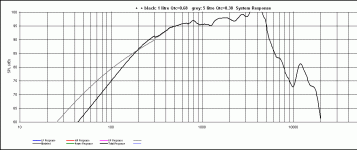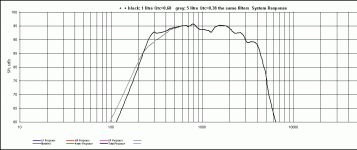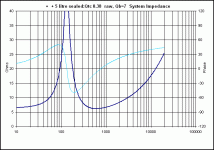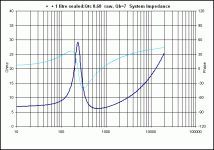Hey guys,
I'm designing a box for the new 6MBX44 for use as a midrange/midwoofer
B&C Speakers
I believe it's too new to have good distortion plots by any user, but it looks like a promising new driver.
It will be crossed at 200/300 and 1.5k. I realize it's speced for a vented cab on the data sheet. B&C has told me it will work well in a sealed cabinet, but low frequencies will be 'a little more limited'. Limiting the low frequencies I see as a help in the crossover design.
I'm thinking of cabinet Qtc values and the resulting box spring distortion. The manufacturer recommends a .45 Qtc box, but I'm more familiar with the .707 value and its sound. I've never tuned any speaker to a Qtc so low. Since the volume of a .707 Qtc enclosure for this driver is so low (less than 1L) I worry about box air spring distortion.
Here are some calculations I whipped up during the box design. I don't plan on blasting this woofer with 400W, but it will be in a high power design in a recording studio. Xmax calculated here is just with the box rolloff (no crossover)
(Xmax is 3.5mm)
Qtc = .45 means 1.9mm @200W 2.7mm @400W
Qtc = .707 means 1.6mm@200W 2.2mm @400W
Box Air Spring Distortion
Qtc = .45 means 1.2% THD @200W 1.7% THD @400W
Qtc = .707 means 3% THD @200W 4.1% THD @400W
The room and reproduction system I use are tuned extremely well, and the design is based around low distortion. Everything is a tradeoff with speakers but I wonder if any users here have had experience in designing midrange/midwoofer low qtc boxes who could weigh in here on what's important
I'm designing a box for the new 6MBX44 for use as a midrange/midwoofer
B&C Speakers
I believe it's too new to have good distortion plots by any user, but it looks like a promising new driver.
It will be crossed at 200/300 and 1.5k. I realize it's speced for a vented cab on the data sheet. B&C has told me it will work well in a sealed cabinet, but low frequencies will be 'a little more limited'. Limiting the low frequencies I see as a help in the crossover design.
I'm thinking of cabinet Qtc values and the resulting box spring distortion. The manufacturer recommends a .45 Qtc box, but I'm more familiar with the .707 value and its sound. I've never tuned any speaker to a Qtc so low. Since the volume of a .707 Qtc enclosure for this driver is so low (less than 1L) I worry about box air spring distortion.
Here are some calculations I whipped up during the box design. I don't plan on blasting this woofer with 400W, but it will be in a high power design in a recording studio. Xmax calculated here is just with the box rolloff (no crossover)
(Xmax is 3.5mm)
Qtc = .45 means 1.9mm @200W 2.7mm @400W
Qtc = .707 means 1.6mm@200W 2.2mm @400W
Box Air Spring Distortion
Qtc = .45 means 1.2% THD @200W 1.7% THD @400W
Qtc = .707 means 3% THD @200W 4.1% THD @400W
The room and reproduction system I use are tuned extremely well, and the design is based around low distortion. Everything is a tradeoff with speakers but I wonder if any users here have had experience in designing midrange/midwoofer low qtc boxes who could weigh in here on what's important
Last edited:
Hi, it seems, thou are running into a little problem indeed there. However low Q raises clang, too, as long as the drive does not come perfectly linearized. Using an active crossover, thou can use an amplifier with positive source resistance in order to raise Q and lessen drive clang, without loosing efficience as when using a real resistor. Uli
Relating back to Speakerbuilder or Audio-X-Press Magazine articles, optimum subjective midrange clarity was stated to be with the Qtc below 0.71, in the 0.5 to 0.6 range. So your manufacturer recommended Qtc = 0.45 doesn't 'sound' (pun intended) too out-of-line.
Relating back to Speakerbuilder or Audio-X-Press Magazine articles, optimum subjective midrange clarity was stated to be with the Qtc below 0.71, in the 0.5 to 0.6 range. So your manufacturer recommended Qtc = 0.45 doesn't 'sound' (pun intended) too out-of-line.
Haha, alright that's good news then! Sounds like .45 would be promising then
Why do you care so much about Qtc when you have no intent
to cross it near its Fs? Qtc isn't an issue in your case. Take care
of how you will design a XO filter in the region of your interest.
Simulation answers many questions if done properly.
to cross it near its Fs? Qtc isn't an issue in your case. Take care
of how you will design a XO filter in the region of your interest.
Simulation answers many questions if done properly.
I care about its relation to air spring distortion, how it affects practical xmax through LF rolloff, and I am unsure how a higher fb will affect performance
Why do you care so much about Qtc when you have no intent
to cross it near its Fs? Qtc isn't an issue in your case. Take care
of how you will design a XO filter in the region of your interest.
Simulation answers many questions if done properly.
You don't benefit from increasing the Qtc if you're crossing
over in the 200-300 Hz range. The HP response at Fs will already
be down by 20 dB and probably more. Do the simulation.
over in the 200-300 Hz range. The HP response at Fs will already
be down by 20 dB and probably more. Do the simulation.
Last edited:
200Hz is close enough to Fb that it could matter.Why do you care so much about Qtc when you have no intent
to cross it near its Fs? Qtc isn't an issue in your case. Take care
of how you will design a XO filter in the region of your interest.
Simulation answers many questions if done properly.
Personally I'd just build two test boxes and measure it.
Is this new driver for Mid range only (you mention 200/300Hz), or is it to be used as a mid bass driver?
If a mid range only, then creating the cross over filter down into the bass driver's range will be very much easier if you use a 2pole Butterworth roll-off, Q=sqrt(2)/2 for the sealed box loading.
If you use it as a sealed box bass and mid, then using a bigger box and allowing Qbox <<0.65 you get a well damped roll off without any bass exaggeration and most think that sounds nice, particularly if you get down to Bessel roll off with Q~0.56
If a mid range only, then creating the cross over filter down into the bass driver's range will be very much easier if you use a 2pole Butterworth roll-off, Q=sqrt(2)/2 for the sealed box loading.
If you use it as a sealed box bass and mid, then using a bigger box and allowing Qbox <<0.65 you get a well damped roll off without any bass exaggeration and most think that sounds nice, particularly if you get down to Bessel roll off with Q~0.56
Where have you got this idea of terrible box spring distortion from? The air makes a very linear load, hence why infinite baffle speakers came about.
B&C 6mbx44-8 ohm
These are simple simulations with not that great splicing at 300 Hz,
but it should give us a taste of what is going on. The smaller cabinet
has significantly higher Fb so the same XO filter because of the Impedance
peak doesn't work the same as in a larger cabinet. In order to have similar
HP response in both of the cabinets the smaller version would need
an RLC Impedance peak compensation and different HP filter values.
These are simple simulations with not that great splicing at 300 Hz,
but it should give us a taste of what is going on. The smaller cabinet
has significantly higher Fb so the same XO filter because of the Impedance
peak doesn't work the same as in a larger cabinet. In order to have similar
HP response in both of the cabinets the smaller version would need
an RLC Impedance peak compensation and different HP filter values.
Attachments
Air spring distortion becomes a problem when you are looking at Vd being 5-10% of Vb
With Vb being 1000cc and Vd being maybe 45, you are below that threshold. Most likely with a crossover @200+ you won't be anywhere near that threshold, but simulate. At high excursions approaching Xmax, distortion from the driver will dominate anyway. What woofer are you using that can only reach 200 or 300?
With Vb being 1000cc and Vd being maybe 45, you are below that threshold. Most likely with a crossover @200+ you won't be anywhere near that threshold, but simulate. At high excursions approaching Xmax, distortion from the driver will dominate anyway. What woofer are you using that can only reach 200 or 300?
Here are some calculations I whipped up during the box design. I don't plan on blasting this woofer with 400W, but it will be in a high power design in a recording studio. Xmax calculated here is just with the box rolloff (no crossover)
(Xmax is 3.5mm)
Qtc = .45 means 1.9mm @200W 2.7mm @400W
Qtc = .707 means 1.6mm@200W 2.2mm @400W
Box Air Spring Distortion
Qtc = .45 means 1.2% THD @200W 1.7% THD @400W
Qtc = .707 means 3% THD @200W 4.1% THD @400W
The room and reproduction system I use are tuned extremely well, and the design is based around low distortion. Everything is a tradeoff with speakers but I wonder if any users here have had experience in designing midrange/midwoofer low qtc boxes who could weigh in here on what's important
You wonder what's important? Well, you are worried about a distortion at the fb at which you aren't using the driver at all? And that's too much distortion for you? Well, at first, keep in mind, the driver itself will have a lot higher distortion than the air spring distortion, after all you are talking about 124dB/1m and being very well over the maximum electrical load. And secondly, I very highly doubt your bass will keep up in any way, whatever you are going to use below the 6", since it WILL have intermodulation distortion problems at that kind of level.
Hi, it seems, thou are running into a little problem indeed there. However low Q raises clang, too, as long as the drive does not come perfectly linearized. Using an active crossover, thou can use an amplifier with positive source resistance in order to raise Q and lessen drive clang, without loosing efficience as when using a real resistor. Uli
You seem to forget that the non-linearity of the air cannot be compensated without active feedback. So your suggestion only adds further non-linearities through the overcompensation instead reducing it.
Hmm, being a prosound mid, I imagine the 0.45 Qtc is recommended due to how much it's likely to rise at sustained high power.
GM
GM
Hmm, being a prosound mid, I imagine the 0.45 Qtc is recommended due to how much it's likely to rise at sustained high power.
GM
That's exactly how to deal with powercompression while planning the speaker. However, since the driver isn't going to be used anywhere near the fb, it's more of a academical question.
I've just simulated it. With a Qtc of 0,5 the B&C 6MBX44 only needs 2,4l, with a Qtc of 0,7 it would be only 1l - you can hardly make the enclosure small enough. So why would that be a problem (or question) at all to go for a lower Qtc?
........it's more of a academical question.
Not when factoring in the XO, but I guess with digital that doesn't matter anymore. Kind of dating myself here. 🙁
GM
Great responses! This board rules. Yes it seems .45 is the way to go for the long variety of reasons ICG and others have stated.
This is a good question
In preliminary simulations of the high pass crossover (2nd order) the driver is down approximately -10dB@150Hz (Fb) and -20dB@90hz (Fs)
Is this close enough to matter?
200Hz is close enough to Fb that it could matter.
Personally I'd just build two test boxes and measure it.
This is a good question
In preliminary simulations of the high pass crossover (2nd order) the driver is down approximately -10dB@150Hz (Fb) and -20dB@90hz (Fs)
Is this close enough to matter?
I think you just answered your own question. The air pressure inside the box is dependant on the position of the cone, therefore the spring rate/constant of the air becomes dependant on the cone position and the cone faces a different amount of air resistance depending on where it is in the stroke - the definition of non-linear.Where have you got this idea of terrible box spring distortion from? The air makes a very linear load, hence why infinite baffle speakers came about.
In open baffle or a sufficiently large box the air cannot be significantly pressurised by the movement of the cone, therefore the problem is mostly avoided.
There is a point where the box becomes too small and the non-linearity of the air exceeds that of the driver's mechanical suspension - hence this thread.
It's more a rule of thumb than a strict guideline. The pressure depends on the displacement volume of the cone (=SPL) and the volume of the box. The amount of distortion depends on how much the pressure in the box is changing. If your SPL requirements are low, or the box is sufficiently large enough, or you crossover high enough then you avoid the problem. Everything is a compromise, so the easiest way is to just try it in practice.In preliminary simulations of the high pass crossover (2nd order) the driver is down approximately -10dB@150Hz (Fb) and -20dB@90hz (Fs)
Is this close enough to matter?
In my car i've come across this problem by putting 3" midranges (Fountek FR89EX) in undersize boxes (~0.5L -> Qtc=0.8~ Fb=180Hz~). As a result there was significantly higher harmonic distortion at and below 200Hz compared to when I tested them open-baffle (quasi-infinite baffle) at an output level of 96dB@1m. In that application I crossed them at 350Hz 24dB/octave and the distortion was not audible.
Assuming you have the space for the larger box, the only benefit of going for Qtc=0.707 is that it may require a little less crossover work. If your goal is low distortion I'd just go for the larger box because baffle diffraction and room effects will probably be a bigger problem than the box Qtc for hitting a flat response.
Last edited:
- Status
- Not open for further replies.
- Home
- Loudspeakers
- Multi-Way
- Midrange sealed box, Qtc and box spring distortion



